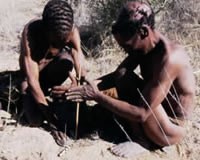Sandawe in Tanzania

Photo Source:
Willem Richter
|
Send Joshua Project a map of this people group.
|
| People Name: | Sandawe |
| Country: | Tanzania |
| 10/40 Window: | No |
| Population: | 90,000 |
| World Population: | 90,000 |
| Primary Language: | Sandawe |
| Primary Religion: | Ethnic Religions |
| Christian Adherents: | 15.00 % |
| Evangelicals: | 5.00 % |
| Scripture: | Portions |
| Ministry Resources: | Yes |
| Jesus Film: | No |
| Audio Recordings: | Yes |
| People Cluster: | Khoisan |
| Affinity Bloc: | Sub-Saharan Peoples |
| Progress Level: |
|
Introduction / History
The Sandawe are a small group living in north-central Tanzania in Kondo District, near the town of Kondoa, between the Mponde and Bubu rivers. The Sandawe are a small remaining group of a race of people that originally lived over much of Africa. The San, called Bushmen by the Dutch in South Africa, were the first people we know in the Rift Valley. The Sandawe are racially different from the surrounding tribes. They have lighter skin and are smaller, with knotty hair like that of the Bushmen, commonly referred to as peppercorn hair. They have the epicanthic fold of the eye lid (like East Asian people) common to the Bushmen.The Sandawe language includes click sounds as consonants and is also tonal. Completely unrelated to other languages in the area, it is challenging to learn. The language is related to the languages of the Bushmen (San) and the Hottentots (Khoi) of the southern Africa and is therefore classified as a Khoisan language. The Hadzapi, also in northern Tanzania, are the only other aboriginal people in Eastern Africa still speaking a Khoisan language.
What Are Their Lives Like?
The Sandawe live in scattered homesteads rather than dense villages. They are primarily subsistence farmers, growing millet, sorghum, and maize, and some also raise livestock. Their homes are often built away from water sources, and water scarcity is a recurring challenge. They are known for their cooperative spirit, especially in farming, homebuilding, and organizing communal hunts.Despite modernization, the Sandawe maintain an oral tradition, enjoy music and dance, and celebrate various seasonal and spiritual festivals. Their culture is deeply tied to the land and ancestral customs.
What Are Their Beliefs?
The Sandawe practice a deeply spiritual form of animism, venerating spirits of nature, ancestors, the moon, stars, and even insects like the mantis, which is seen as a divine messenger. Sacred caves are believed to house spirits and are visited for ritual sacrifices and prayers. While there is a distant creator god named Warongwe, he is rarely worshipped directly.Some Sandawe have converted to Christianity particularly Roman Catholicism, and a smaller number to Islam. However, syncretism is common, with traditional beliefs often blended into newer religious practices.
What Are Their Needs?
The Sandawe need a complete Bible translation in their language. Translation work is ongoing but slow, and the language's complexity makes it difficult to produce and distribute Scripture effectively.They need improved access to clean water. Seasonal droughts and broken village pumps often force people to walk long distances for water.Educational resources in both Swahili and Sandawe are needed. While many children attend school, adult literacy in Sandawe remains low, limiting Scripture engagement.Healthcare services are limited. Many Sandawe live far from clinics, and traditional healing practices are still widely used.Spiritual outreach and discipleship programs are essential. Evangelical presence is minimal and many believers lack access to biblical teaching.
Prayer Points
Pray for the completion and effective distribution of the Bible in the Sandawe language.Ask God to raise up local believers and leaders who can disciple others and plant churches.Pray for spiritual openness among the Sandawe and for the breaking of fear-based animistic practices.Intercede for missionaries and translation teams that they may have wisdom, endurance, and cultural sensitivity.Pray for holistic transformation, including clean water, education, and healthcare, to accompany spiritual renewal.